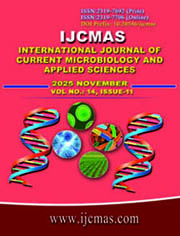


 National Academy of Agricultural Sciences (NAAS)
National Academy of Agricultural Sciences (NAAS)

|
PRINT ISSN : 2319-7692
Online ISSN : 2319-7706 Issues : 12 per year Publisher : Excellent Publishers Email : editorijcmas@gmail.com / submit@ijcmas.com Editor-in-chief: Dr.M.Prakash Index Copernicus ICV 2018: 95.39 NAAS RATING 2020: 5.38 |
The increasing consumption of gutkha, a smokeless tobacco product, poses severe public health risks due to its high nicotine, areca nut alkaloids, slaked lime and catechu—substances known to cause serious oral and systemic health problems. Nicotine is the major addictive and toxic compound, while catechu and lime contribute to severe staining of oral tissues and public spaces. This study investigates the probiotic bacterium Lacticaseibacillus paracasei for its potential to degrade nicotine and reduce catechu-induced stains. L. paracasei was isolated from fermented milk products and identified based on morphological and molecular characteristics. Nicotine degradation and stain-reducing activities were quantified spectrophotometrically. The Lacticaseibacillus paracasei isolate exhibited significant nicotine degradation efficiency and noticeable reduction of catechu stains. These findings suggest that L. paracasei can serve as a potential bio-agent for developing probiotic formulations or modified gutkha products aimed at reducing tobacco-related toxicity and improving public hygiene.
Campain, J. A. (2004). Nicotine: potentially a multifunctional carcinogen? Toxicological Sciences, 79(1), 1-3. https://doi.org/10.1093/toxsci/kfh106
CDC, Fact Sheet: Betel Quid with Tobacco (Gutka) 2007. Available online: http://www.cdc.gov/ tobacco/data_statistics/fact_sheets/smokeless/betel_quid/ (accessed on 8 January 2014).
Chadha, P., & Yadav, J. S. (2011). Studies on the Genotoxicity of Gutkha. International Journal of Human Genetics, 11(4), 277-282. https://doi.org/10.1080/09723757.2011.11886153
Changrani, J., & Gany, F. (2005). Paan and Gutka in the United States: an emerging threat. Journal of immigrant health, 7(2), 103-108. https://doi.org/10.1007/s10903-005-2643-7
Do, E. T. T., & Vu, M. (2020). A qualitative study of gutka and paan masala use among Bhutanese and Burmese migrants in Georgia. PloS one, 15(8), e0237266. https://doi.org/10.1371/journal.pone.0237266
Hawaz, E. (2014). Isolation and identification of probiotic lactic acid bacteria from curd and in vitro evaluation of its growth inhibition activities against pathogenic bacteria. African Journal of Microbiology Research, 8(13), 1419-1425.
Hoffmann, D., & Hecht, S. S. (1985). Nicotine-derived N-nitrosamines and tobacco-related cancer: current status and future directions. Cancer research, 45(3), 935–944.
Hossain, A. M., & Salehuddin, S. M. (2013). Analytical determination of nicotine in tobacco leaves by gas chromatography–mass spectrometry. Arabian Journal of Chemistry, 6(3), 275-278. https://doi.org/10.1016/j.arabjc.2010.10.018
Keshava Bhat, S., Ashwin, D., Mythri, S., & Bhat, S. (2018). Arecanut (Areca catechu L.) is not carcinogenic but cures cancer: A bibliography. International Journal of Medical Research & Health Sciences, 4, 35-40.
Nair, U., Bartsch, H., & Nair, J. (2004). Alert for an epidemic of oral cancer due to use of the betel quid substitutes gutkha and pan masala: a review of agents and causative mechanisms. Mutagenesis, 19(4), 251-262. https://doi.org/10.1093/mutage/geg028
Omara, H. A., & Attaf, S. M. (2014). Spectrophotometric determination of nicotine in Cigarette tobacco and biological samples of smokers. World Journal of Pharmacy and Pharmaceutical Sciences, 3(8), 1327-1340.
Qiao, D., Seidler, F. J., & Slotkin, T. A. (2005). Oxidative mechanisms contributing to the developmental neurotoxicity of nicotine and chlorpyrifos. Toxicology and applied pharmacology, 206(1), 17-26. https://doi.org/10.1016/j.taap.2004.10.005
Sabha, M., Tanus?Santos, J. E., Toledo, J. C. Y., Cittadino, M., Rocha, J. C., & Moreno, H. (2000). Transdermal nicotine mimics the smoking?induced endothelial dysfunction. Clinical Pharmacology & Therapeutics, 68(2), 167-174. https://doi.org/10.1067/mcp.2000.107864
Sankhla, B., Kachhwaha, K., Hussain, S. Y., Saxena, S., Sireesha, S. K., & Bhargava, A. (2018). Genotoxic and carcinogenic effect of gutkha: a fast-growing smokeless tobacco. Addiction & health, 10(1), 52. https://doi.org/10.1093/carcin/11.12.2145
Schievelbein, H. (1982). Nicotine, resorption and fate. Pharmacology & therapeutics, 18(2), 233-247.
Strickland, S. S. (2002). Anthropological perspectives on use of the areca nut. Addiction biology, 7(1), 85-97. https://doi.org/10.1080/13556210120091446
The Merck Index, (1989). 11th ed., Reynolds Tobacco Company, p. 1030.
Willis, D. N., Popovech, M. A., Gany, F., Hoffman, C., Blum, J. L., & Zelikoff, J. T. (2014). Toxicity of gutkha, a smokeless tobacco product gone global: is there more to the toxicity than nicotine? International journal of environmental research and public health, 11(1), 919-933. https://doi.org/10.3390/ijerph110100919
World Health Organization. (2012). WHO global report on mortality attributable to tobacco.
Yildiz, D. (2004). Nicotine, its metabolism and an overview of its biological effects. Toxicon, 43(6), 619-632. https://doi.org/10.1016/j.toxicon.2004.03.022
Yildiz, D., Ercal, N., & Armstrong, D. W. (1998). Nicotine enantiomers and oxidative stress. Toxicology, 130(2-3), 155-165. https://doi.org/10.1016/S0300-483X(98)00069-2 |
 |
 |
 |
 |